Message 78, 1 December 2003
You'll note in the image shown of my specimen of the HGU-14/P helmet that it features
black plastic single-blade bayonet receivers. There is further interesting information
relating to these receivers that ties directly into Bluelight's current investigation into
the chronological and sequential associations that Sierra Engineering, Protection
Incorporated, TopTex, Flight Suits Limited, Scott Aviation, and Gentex had with each
other.
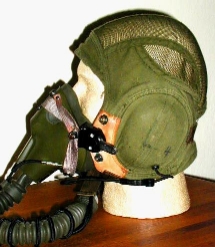

Gentex HGU-14/P helmet with black snap-on oxygen mask receivers
As per the black plastic receivers, the original design for these receivers was a Sierra
Engineering development (as were many oxygen-related system components in the 60s). The
receivers shown on my HGU-14/P came installed on the helmet and are clearly intended to
take either the standard "long straight" single bladed bayonets. Recall that the
US Air Force never used the single long straight blade bayonet as a standard oxygen
mask retention device with the old MS22001 oxygen mask (that is, with the original A-13A
type, without Hardman kit shell installed); Germany in fact did so, and I believe several
other countries as well, but in the USA, the single straight blade bayonet was only
conventionally used in conjunction with the Hardman Kit assembly
I have included pictures of three different types of these hard plastic single straight
long blade bayonet receivers in the separate ZIPfile. The first is the original, early
Sierra Engineering receiver, assigned Sierra Part Number 345-125 (FSN 1660-885-2109). This
receiver was a single piece molded plastic unit with ratcheted teeth along both sides and
it was designed with two circular concavities molded in to the bottom which
would fit over the standard flight helmet snaps of a soft flying helmet. The receiver was
secured to the snaps by use of a five-eighths inch long small diameter screw in very much
the same manner that the metal-tanged oxygen mask fasteners would be screwed to the snaps
on a P-helmet's leather tabs (since the military snaps had internally threaded orifices).
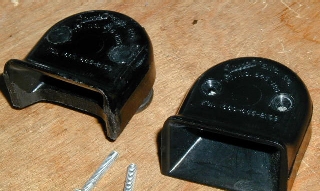
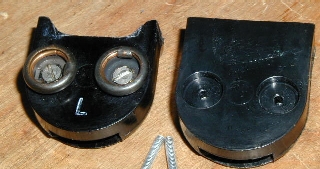
Late modified Sierra receiver (left) and original Sierra receiver (right)
At some point, it was decided by Sierra Engineering to modify this molded black plastic
receiver. This resulted in what I term the "late modified" Sierra Engineering
receiver, which is merely the early and original model with the inner lip cut away and
snaps fastened to the bottom of the receiver. Study the pictures showing the original and
the modified receivers and you will see the machining marks on the inner plastic lip
where it has been cut away on the modified receiver. There was no change in the molded
part number on these modified receivers, although Sierra Engineering may have had an
internal part number for them. This modified receiver appears, to the best of my powers of
observation, to have been produced to allow the new "short straight" blade
bayonet (Sierra Part Number 345-309) to be used on helmets fitted with snaps, since the
original plastic receiver could not be satisfactorily used with the new short blade
bayonets. You will recall that these newer "short straight" blade bayonets were
also used briefly on US Navy APH-6 type helmets together with the short-lived "angled
box" receivers that was attempted as a successor to the earlier standard 'ratcheted
cutout' receiver that almost all APH-6 helmet are today seen to have been fitted with.
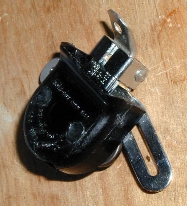
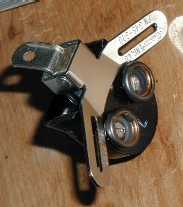
Late modified Sierra receiver with "short straight" blade
bayonet (Sierra p/n 345-309)
It seems clear enough to me that the original black plastic receivers were intended to be
used only with the original "long straight" blade bayonets, but this allowed the
end of the bayonet to protrude through the aft end of the receiver slot by about half an
inch, thereby creating what seems to be a potentially hazardous snagging point for
parachute risers upon bailout. The modified receiver, with its use of the short-bladed
bayonets did not pose that same hazard, since not only did the short blade not
protrude beyond the end of the receiver, but the receivers themselves were also
fitted with snaps that could theoretically release upon sustaining a sharp enough impact
(they were usually directional "Pull-the-Dot" types, although the modified
receiver could be used with standard non-directional snaps, at the discretion of life
support personnel). Additionally, the top screw access holes were plugged on the second
Sierra ('late modified') version and screws were instead used on the underside (fitted
from beneath in the same holes) to hold the female snap retainers in place.
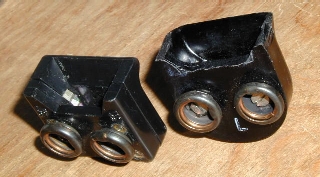
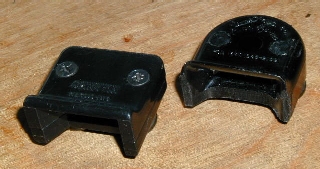
Gentex (left) and a late modified Sierra receiver (right)
Finally, the third receiver shown in the images is of the third version of this type,
which is clearly labeled a GENTEX product (molded into the plastic). This suggests that
sometime after the modified ("2nd-gen") Sierra black plastic receiver was
produced, Sierra Engineering was sold to or incorporated into Gentex. The third
(Gentex) version is also a squarish unit and is not slightly rounded, as was the
Sierra precursor; look closely at the details shown in the images and you will see these
differences. Finally, the last Gentex made receiver has been molded in two parts which
were secured together by two top-screws. On the underside, screws were still used to
retain the female snap components in place, as had also been the case with the
second Sierra ('late modified) version.
Cheers, DocBoink